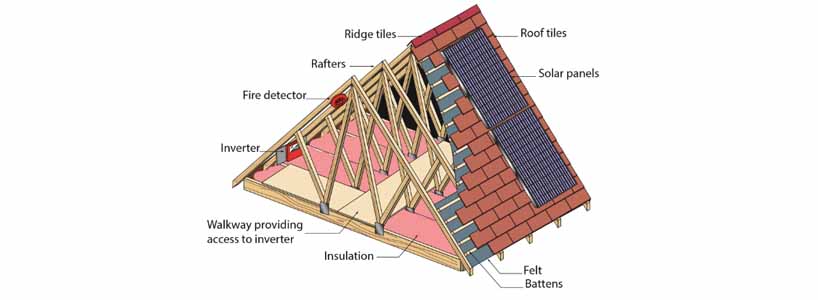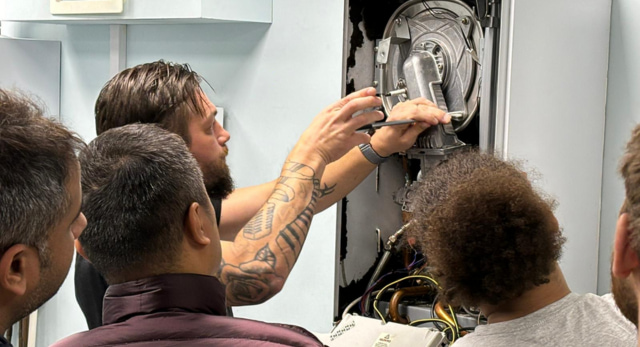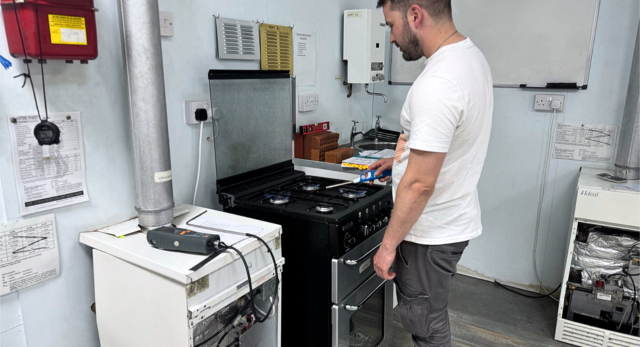If electrical equipment such as solar PV, battery storage, ventilation units, or smart tech is installed in your loft, updated UK regulations make fire safety non-negotiable. This article covers why lofts present unique fire risks, what the standards require, and exactly how to protect life and property. From choosing the right alarms to ongoing maintenance, safe installation, and risk assessment.
Why Electrical Fire Safety in Lofts Matters
Lofts increasingly house essential electrical equipment ranging from boilers and ventilation units to solar inverters and batteries. These installations present unique fire risks and accessibility challenges, making tailored fire protection both a regulatory requirement and a critical safety measure.
- Modern homes routinely use lofts for electrical plant and smart tech.
- Risks are increased due to difficult access, poor visibility, and fire spread potential.
- Compliance with the latest standards (BS 5839-6:2025, Electricity at Work Regulations, and Approved Document B) is essential.
Ensuring correct fire protection is not merely a compliance issue but an essential proactive measure. Meeting standards such as BS 5839-6:2025 and the Electricity at Work Regulations is crucial because they reflect up-to-date research into how fires start and propagate in loft environments, where detection and escape are more demanding.
Properly installed and regularly maintained smoke alarms in lofts, use of suitable wiring and current protection, and safe working practices help protect life and property, especially as loft equipment now frequently serves whole-house energy and connectivity roles. This multidimensional risk, combining electrics and fire, means loft fire safety demands rigorous attention to evolving regulations.
Legal Requirements and British Standards
BS 5839-6:2025
The British Standard for domestic fire detection (BS 5839-6:2025) firmly recognises the need for loft-based smoke alarms if electrical equipment is present. Any electrical item installed in a residential loft now mandates fire protection specifically, a smoke detector as part of a Grade D Category LD2 fire detection system.
- Clause 11 (Location and siting of fire detectors) – In cases where certain electrical equipment is mounted in the loft, a Category LD2 system might incorporate a smoke detector within the loft space.
- Clause A.6 of Annex A (Consideration of ignition sources) – Electrical appliances and wiring are the second most common source of ignition of accidental fires in dwellings. Electrical equipment mounted in lofts contribute to the fire statistics and, where the loft is selected for mounting such equipment, there might be justification for a fire detector*.
- Clause 4.2 – Fire detectors in single-family domestic premises are generally mounted in kitchens, hallways, landings and lounges to form a Grade D Category LD2 fire detection and fire alarm system for protection of life. However, the fire risk assessment may identify additional risk factors which may warrant, for example, a fire detector in the loft
- Clauses 11.2(n) and 12.2(a) – Should a fire detector be selected for the loft, it must, amongst other things, be accessible for maintenance and have accessible means of being silenced in the event of a false alarm
Electricity at Work Regulations (1989)
Regulation 132.12 of BS 7671 and Regulation 15 of the Electricity at Work Regulations require that:
- Equipment is safely accessible for inspection and repairs.
- Loft areas with equipment provide proper lighting and safe working platforms.
Building Regulations and Approved Document B
All new dwellings require smoke alarms meeting BS 5839-6, Grade D2 LD3 minimum. Additonally, lofts with equipment often demand enhanced LD2 protection.
- Loft conversions also require fire-resistant doors and compliant escape routes.
Key Fire Risks Associated with Loft-Based Electrical Equipment
Common Installations and Hazards
Some typical loft installations include:
- Solar PV inverters & battery storage systems
- Boilers and mechanical ventilation units (MVHR)
- Smart home hubs and telecoms equipment
- Water pumps and heating control modules
These bring increased risks due to:
- Electrical faults causing ignition
- Hidden locations mean fires go undetected for longer
- Accumulated dust and insulation elevating fire spread potential.
Any electrical equipment installed just about anywhere, in the event of a fault or incorrect installation, can become a source of ignition. So it’s important to be aware that a loft’s nature could provide a ready source which can enable a fire to become rapidly established.
This is because a loft consists of exposed timbers and could also have a flammable roof covering like thatch or felt. Lofts are also used as storage, so they are often filled with combustible things like cardboard boxes.
As a result, it’s important to make sure that the operation of the equipment doesn’t present a fire risk. It’s also important to take into account the manufacturer’s instructions or any equipment already installed in the loft (Regulation 134.1.1 of BS 7671 refers).
Risk Factors to Assess
Fire risk assessment should consider:
- Likelihood of fire from specific equipment types and age.
- The speed at which fire could spread in an insulated loft.
- Whether early alarm can safely warn occupants or contractors.
Whenever electrical equipment is installed in a loft, it needs to be accessible so contractors can carry out the necessary maintenance and repairs. (Regulation 132.12 of BS 7671 refers).
The equipment also needs to be on a safe, working platform with adequate lighting to avoid hazards when contractors enter the loft. (Regulation 15 of the Electricity at Work Regulations 1989 refers).
Without the above, both the occupants and contractors could be put at risk.
What Does Compliance Look Like in 2025?
Detectors and Control Systems
For most British homes:
- Install an interlinked smoke detector in every loft housing electrical equipment as part of the fire alarm system.
- Prefer multi-sensor detectors to minimise nuisance alarms from dust.
- Ensure alarms are accessible for routine testing and maintenance.
Detector Placement and Accessibility
- Smoke detectors should be placed away from sources of dust and at optimal heights for smoke detection but within reach for maintenance.
- Consider fitting alarm controllers (e.g., wireless remote silencing and testing switches) in more readily accessible parts of the property, especially if the loft is rarely entered.
- Interlink the loft detector with the rest of the home’s alarm network for full coverage.
Fire Risk Assessment
In order to work out if a fire detector is needed in the loft space, a fire risk assessment must be taken into account in addition to the following;
- The probability of fire occurring in the location
- The probability of early detection and warning to occupants before significant fire spread occurs.
By providing a fire detector, an installer will be providing residents with an early warning signal, which will give them enough time to leave safely and call the Fire service. As a result, this should keep the residents out of danger and reduce the amount of potential damage to the property.
Practical Steps for Contractors and Property Owners
Pre-Installation
- Conduct a fire risk assessment for every loft installation—whether for a new build, conversion, or retrofitted equipment.
- Select suitable alarm types and Grade systems based on BS 5839-6:2025, ideally LD2 or LD1 coverage.
- Plan access (per Electricity at Work Regulations) with safe working platforms and sufficient lighting.
Post-Installation
- Test alarms routinely; check accessibility and signage.
- Train household members on alarm operation and evacuation plans.
- Keep compliance records for domestic installations, including certification and risk assessment documentation.
Maintenance & Upgrades
- Replace batteries or whole detectors per manufacturer guidance.
- Upgrade older systems and wiring to current standards.
- Document all checks, servicing, and any changes to equipment.
The Impact of Solar, Ventilation, Smart Tech on Fire Safety
With solar PV and smart home devices now common, fire safety in lofts moves beyond old-style boilers. Installers and homeowners should be aware that:
- Solar and battery storage systems have unique fire risks due to electrical surges and lithium batteries.
- Multi-room ventilation units (MVHR, MEV) add complexity and need tailored fire protection.
- Smart hubs may require continuous power, meaning more cabling and potential heat build-up.
Solar photovoltaic (PV) panels and battery storage systems present specific dangers: electrical surges, faulty inverters, or physical damage can trigger fires that are difficult to detect in a loft and are complicated further by lithium batteries’ potential for thermal runaway that can lead to rapid and hard-to-extinguish blazes. Notably, fires linked to solar systems often escalate quickly because even when mains power is isolated, daylight can keep PV circuits energised, and the proximity to timber and stored items in lofts can enhance fire spread.
Modern ventilation systems such as MVHR (Mechanical Ventilation with Heat Recovery) or PIV (Positive Input Ventilation) units require continuous power and may introduce additional wiring and junctions in confined loft areas, increasing the risk of overheating and accidental ignition. Guidance now stresses that such units should be interlinked with fire detection systems, so that their electrical supply is automatically isolated in a fire event, reflecting the complexity created by these new technologies.
Smart home devices, with their persistent electrical demands and often-intensive networking hardware, add further cumulative heat loads and cabling density in lofts. These developments demand tailored fire protection methods that include careful circuit planning and regular risk assessment to keep pace with the evolving technology landscape and to ensure protection complies with the latest standards.
Recognising these risks means that both technical knowledge and up-to-date practical skills are now more important than ever. As the demands of fire safety evolve alongside new technology, high-quality training is the key to reliable compliance and peace of mind for homeowners and contractors alike.
Summary
This article has highlighted how lofts, now often packed with electrical plant like solar inverters, batteries, and ventilation systems, pose a distinct fire risk due to hidden ignition sources, rapid fire spread, and limited access for maintenance or escape. It’s crucial to understand that, beyond following BS 5839-6:2025, risk assessments and tailored fire detection strategies protect not just property but lives as well.
From practical experience, we advise starting with a thorough risk assessment for any loft installation, considering both the specific equipment and the intended use of the space. Always opt for interlinked, mains-powered smoke alarms with accessible controls. Use only competent, certified tradespeople or contractors to ensure installation quality, ongoing safe access, and that the right documentation (including risk assessments and compliance certificates) is kept current.
Additionally, regularly check all alarms and electrical systems, and upgrade any old installations to meet the latest standards. Never neglect safe working platforms and sufficient lighting, and always isolate the electrical supply in the event of fire, as it can be life-saving, especially with solar or battery equipment. Above all, involve residents in safety drills and alarm tests, so they understand how to respond if an alarm sounds.
These practical steps reflect Logic4training’s ongoing commitment to supporting safer homes through effective training, up-to-date guidance, and support for both experienced tradespeople and contractors, as well as those new to the industry. For tailored advice or training, reach out to Logic4training or explore our electrical safety courses.
For any further guidance, please use the resources below:
- NICEIC Guidance: NICEIC website
- Approved Document B Fire Safety FAQs: gov.uk resource on fire detection in new dwellings
- British Standard: BS 5839-1:2025
Frequently Asked Questions
Is a smoke detector always required in lofts with electrical equipment?
Yes. Current British Standards and Building Regulations consistently require fire detection in any loft space housing electrical equipment to protect life and property.
What British Standard applies to loft fire protection in 2025?
BS 5839-6:2025 governs domestic fire detection and alarms, outlining smoke detector placement, system grading, and maintenance protocols.
How often should loft smoke alarms be tested or serviced?
Manufacturers recommend annual testing and immediate service if faults or battery issues arise. Accessible placement makes maintenance practical.
Can I fit a remote controller for my loft alarm?
Yes. Wireless remote alarm controllers are recommended, especially for lofts, letting users test, silence, or locate alarms from accessible positions elsewhere in the home.
Where can I learn more about domestic fire risk assessment and compliance?
Logic4training provides detailed courses, including the Electrical Safety Awareness and Domestic Electrical Installer Part P programs. These cover risk assessment, regulation compliance, installation, and certification.









